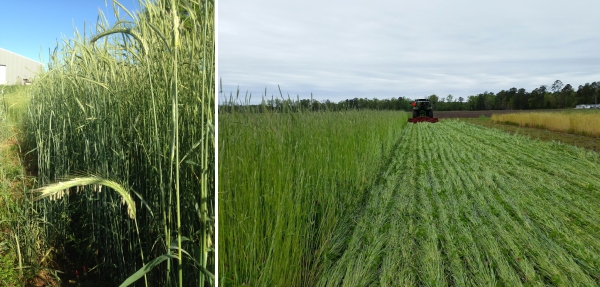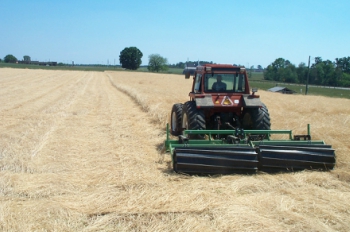Termination with Rolling and Crimping
Both conventional and organic producers use rolling and crimping to terminate cover crops in no-till systems. Rolling flattens the cover down to form a mulch layer. The crimping does not cut the cover crop stems, but stops the flow of water from the roots to the shoots and the flow of sugars from the shoots to the roots by crimping their vascular system.
Experience and research have shown that it is easier to plant into a rolled and crimped cover crop where the cover crop roots are still holding the residue in place, than it is to plant into mowed cover crop residue where moveable pieces of the cover crop will likely wrap and clog up the planter.
 Paying attention to the growth stage of a cover crop is important when using this practice. After covers have begun blooming, many cover species can be terminated by rolling and crimping without using herbicides. The optimal time to terminate small grains with a roller/crimper is at anthesis (lefthand photo) to the soft dough stage (righthand photo).
Paying attention to the growth stage of a cover crop is important when using this practice. After covers have begun blooming, many cover species can be terminated by rolling and crimping without using herbicides. The optimal time to terminate small grains with a roller/crimper is at anthesis (lefthand photo) to the soft dough stage (righthand photo).
Anthesis can be determined by looking for pollen-containing structures on the plants. Rye will produce anthers that are approximately 1/4-1/2” long that will hang from the developing seedhead. Wheat anthers do not hang from the seedheads as conspicuously, though they will still be visible. You should time rolling/crimping to when these pollen structures are visible AND coated with yellow pollen on > 80% of plants in the field. The soft dough stage is when a developing seed can be punctured with a fingernail. Rolling/crimping too early risks poor termination because the plants’ vascular system is not damaged sufficiently, and the cover crop may survive to compete with your cash crop. In addition, the early rolled and crimped cover crop is not likely to remain flat. Terminating the small grain cover crop later than soft dough risks the cover crop producing viable seeds which can sprout in your cash crop.
Broadleaf and legume cover crops are difficult to kill by rolling and crimping. Broadleaf plants should be in full flower for optimal mechanical termination. For plants like vetch with multiple flowers, more than 80% of the flowers should be open. Rolling and crimping alone is not an effective termination method for crimson clover and other clovers. Rapeseed is also difficult to terminate with rolling and crimping. Both the legumes and rapeseed may require multiple trips across the field for an effective kill if herbicides are not used.

Roller/crimper with a chevron or curved bar design.
Cover crop growth stage is particularly important if you are an organic producer as you don’t have the option for a “rescue” herbicide treatment to kill poorly-terminated cover crops. Specific information for organic production will be coming soon.
There are many different types of roller/crimpers available. Roller/crimpers with a chevron or curved bar design help prevent bouncing in the field compared to those with straight bars. However, straight bars may be more effective for breaking a plants’ vascular structures. Further information on rollers/crimpers can be found here. Producers that also use herbicides often just roll the cover crop down and rely on the herbicide to kill the plant.
More Information:
- A Simple Guide for Conservation Systems in the Southeast. USDA ARS
- Termination of Cover Crops: Management Considerations for the Subsequent Cash Crop. Conservation Systems Fact Sheet No. 11. USDA ARS
Contributors:
Dr. Charlie Cahoon, Extension Specialist, Virginia Tech; Dr. Stanley Culpepper, Extension Specialist, University of Georgia; Dr. Mike Flessner, Extension Specialist, Virginia Tech; Julia Gaskin, Extension Specialist, University of Georgia; Dr. Erin Haramoto, Assistant Professor, University of Kentucky; Dr. Andy Price, USDA Agricultural Research Service; Dr. Mark Reiter, Extension Specialist, Virginia Tech; Dr. William Vencill, Professor, University of Georgia
